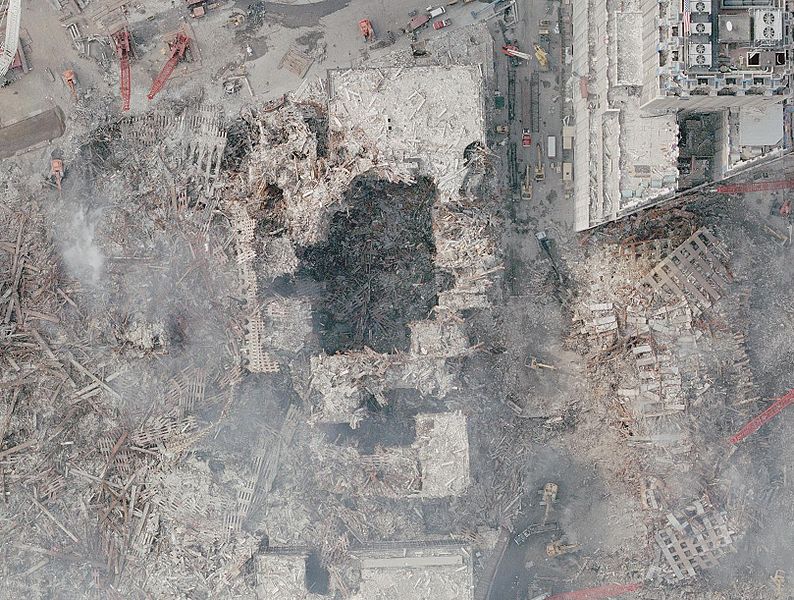I'm sure people have heard and seen plenty about the tenth anniversary of 9/11 by now, but here goes.
I was in the World Trade Center three times. The first was as a tourist, visiting the observation platform atop the South Tower.
The second time was in 1983, as a feature writer. I was touring the structure to research a Smithsonian article on how three modern structures would age if abandoned by civilization, like the seven wonders of the ancient world.
The three modern wonders I profiled were the WTC towers, the Grand Coulee Dam, and the St. Louis Gateway Arch. My March 1984 article is reprinted here.
For my WTC work, a Port Authority staffer let me onto the roof of the North Tower, the one studded with antennas. Based on a lengthy interview with WTC chief structural engineer Leslie Robertson, my article predicted the abandoned, wind-swept Twin Towers tumbling into the Hudson within a thousand years, give or take. Here's an illustration from the "Engineers vs. the Eons" article:
During the interview I asked Les Robertson if he thought the buildings might fall into each other in domino fashion, and he was quite firm that they would never do so.
The third visit was to research an added chapter to Inviting Disaster about engineering and evacuation aspects of the WTC collapse. In that chapter I explained why the towers didn't fall into each other despite the airliners' trajectories, and why the collapse of the South Tower didn't trigger the immediate collapse of the North Tower.
After some months of deliberation, the Port Authority allowed me to spend a day at Ground Zero, shadowing engineer Pablo Lopez on an inspection visit for his employer, Mueser Rutledge. That was in March 2002. I had less than a day's notice to get to New York; I checked into my hotel at 2:30 a.m. and met Pablo first thing that morning.
Pablo's job was to make the rounds of Ground Zero and ensure that excavation of the rubble didn't jeopardize the concrete slurry walls that make up the perimeter of the big basement. He worked out of an engineers' field office set up in kindergarten classrooms on the second floor of nearby Public School 89.
Here's an excellent paper by George Tamaro on the slurry walls' construction and how they held up during the collapse and recovery. We spent most of the time on the northern side of the site, in the wreckage of WTC 6, also known as the Customs House.
The events of 9/11 didn't obliterate the Customs House like the Twin Towers, but did punch a mighty hole all the way through to the basement:
The waffle-like objects are wall panels from the North Tower, a combination of steel columns and spandrel beams that gave the building its extraordinary ability to resist a direct impact from a jetliner at top speed.
As we walked each accessible floor, Pablo showed me cars in the parking garage that had been sheared in half by structural steel falling from the upper floors of the North Tower. Some of that was tightly jammed into the bottom of the big hole; I was reminded of the wreckage that results when two freight trains collide inside a tunnel: twisted and very dense.
The exterior walls on the south were gone so we could see firefighters outside, rooting through rubble with garden rakes. The rubble was a dull-gray mix of metal, fragmented concrete, scraps of textile, dirt, and a great deal of paper that months of weather had aged to parchment. I saw some correspondence from the Green Coffee Association.
One image that sticks with me was the view into an underground coffee shop at the commuter station where the PATH tubes entered the Trade Center. Pablo wanted to check on the tunnels under the Hudson, and we looked into the shop while walking down the track. The snack bar was dusty but mostly intact. There were plates, cups, and newspapers abandoned on the tables.
I never felt that we were in any danger, but it was sobering to read later that one of the WTC 6 floors we were on had collapsed the next day.
That reminds me of a few unwritten rules when shadowing an expert into uncontrolled areas: stick close; wear the protective gear; help serve as a second pair of eyes to look for hazards; and if he or she says it's time to back up and take another route, don't argue!



No comments:
Post a Comment